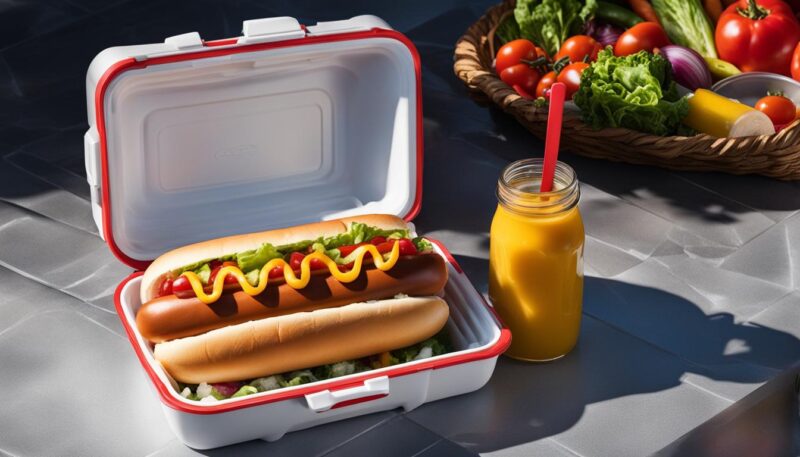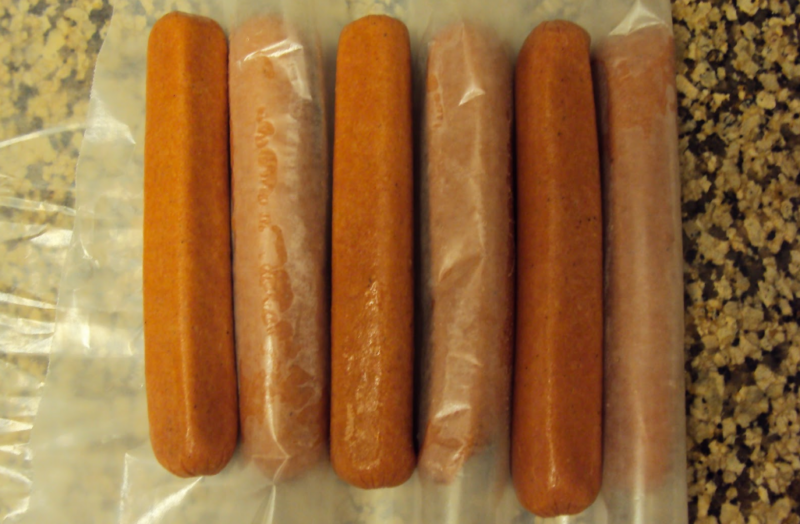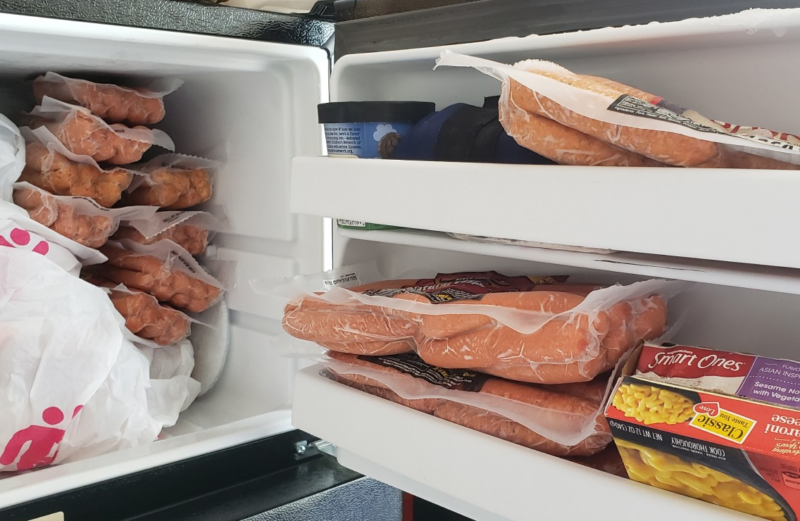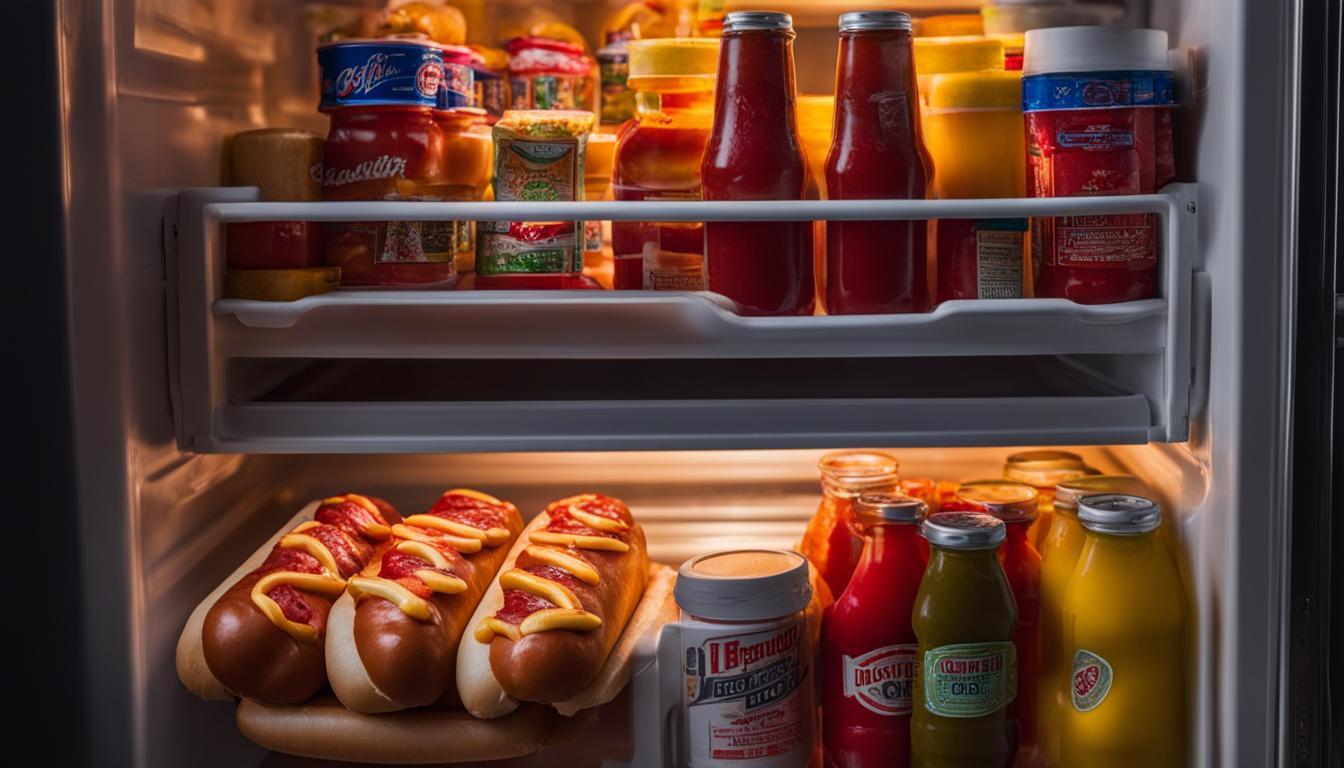As someone who has often mused over the contents of the cold section in the supermarket, I’ve asked myself, “how long do hot dogs last in the fridge?” It’s a valid concern, especially considering the United States Department of Agriculture (USDA) hot dog storage guidelines suggest that an unopened package of hotdogs is fine for about two weeks in the fridge.
Once you break the seal, though, that window narrows—you have roughly a week to enjoy those franks. And while we might like to think our favorite cookout treat is impervious to time, the truth is they are not immune to spoilage.
Do hot dogs go bad? Absolutely, and recognizing the freshness of your hot dogs is something you don’t want to relish.
It’s not just about the hot dogs expiration date; there’s more at steak—my apologies, I mean stake. Bacterial culprits such as listeria monocytogenes loom around charcuterie corners, ready to spoil the party, which reiterates the importance of adhering to proper storage guidelines.
Let’s face it, food poisoning doesn’t belong on anyone’s menu. So, join me as we explore the shelf life of these beloved buns’ best friend and how to ensure they remain a safe and tasty treat.
Understanding Hot Dogs’ Shelf Life in the Refrigerator

As we delve into the world of hot dogs in the refrigerator, it’s important to grasp the critical variables influencing hot dogs shelf life. My readers often reach out with concerns about the longevity of their refrigerated meats, eager to savor their flavors without risking their health.
Knowing when a hot dog has overstayed its welcome in the comfort of your fridge is a balance of art and awareness, which I’m here to unpack.
For those of us keen on preserving hot dogs in the refrigerator, it’s comforting to learn that our fridges offer around two weeks of shelter for an unopened package of hot dogs. However, the moment that package breathes in the first waft of your kitchen’s air, the countdown begins.
You’ve got approximately one week to either consume those hot dogs or adapt your storage strategies to ensure they don’t transform into a petri dish for bacteria.
There’s a delicate dance to perfecting refrigeration storage, with the ultimate step being vigilance. Make no mistake, the nemesis of many a hot dog lover is the omnipresent bacterial growth leading to illnesses we’d all prefer to avoid. Herein lies the motive to wield your refrigerator’s power wisely and pit it successfully against encroaching microbes.
According to the USDA, an unopened package of hot dogs can dwell within the chilly confines of your fridge for about two weeks post-purchase. Once the package is opened, a fleeting window of one week stands between utmost enjoyment and potential spoilage.
| Status of Hot Dog Package | Refrigerator Shelf Life |
|---|---|
| Unopened | Up to 2 weeks |
| Opened | Up to 1 week |
It’s worth noting that these durations aren’t mere whims of fate but scientifically founded timeframes designed to deter a bacterial banquet. If the idea of wasting food irks you as much as it does us—and we suspect it does—then respecting these deadlines becomes second nature.
Join us as we continue this exploration, aiming not merely to shed light on the practicalities of hot dog storage, but to equip you with a newfound reverence for the humble yet mighty refrigerator. Together, we’ll ensure those beloved tubes of delight reach their destinial consumption, in both safety and peak flavor.
Factors That Affect How Long Hot Dogs Stay Fresh

As a detail-oriented consumer, one might ponder what precisely affects the freshness of hot dogs in our household fridges. Let’s uncloak the mystery surrounding factors affecting hot dogs freshness.
The longevity of these easy snacks is not merely a matter of chance but influenced by various elements that, when managed efficiently, can ensure optimal enjoyment up until their last savory bite.
Initially, preservatives play a crucial role. They are added to prolong shelf-life and fend off bacterial contamination in hot dogs. However, preservatives can only do so much.
The robustness of the curing process further dictates how well hot dogs resist the inevitable march of bacteria like listeria, salmonella, and staphylococcus aureus, infamous for their spoilage schemes.
The temperature of your refrigerator is also paramount to hot dog preservation. Inconsistent or inadequate cooling can accelerate bacterial growth, compromising not only the quality but also the safety of your food.
To maintain hot dog freshness, your refrigerator should operate efficiently, keeping these meats well below the temperature danger zone where bacteria thrive.
One cannot underestimate the vigilance needed to maintain the freshness of both unopened and opened packages of hot dogs. Awareness of the intricacies of storage conditions is essential to prevent them from becoming a vessel for bacterial proliferation.
| Storage Factor | Impact on Freshness |
|---|---|
| Presence of Preservatives | Extends shelf-life by inhibiting bacterial growth |
| Curing Process | Enhances resistance against spoilage |
| Fridge Temperature | Should be consistent to slow down bacterial activity |
| Exposure to Bacteria | Potential for spoilage increases with bacterial contamination |
Putting it all together, these factors interplay to either maintain the freshness of hot dogs or shorten their fridge life. It’s a constant battle against time and unseen microbial forces. But fear not, with adequate knowledge and vigilant practices—we, the defenders of our fridges, can ensure the safety and longevity of our favorite hot dog brands.
In sum, while preservatives and curing are the first lines of defense against spoilage, the real guardian of longevity is the consistent and cool environment provided by our refrigerators. Remember, proper refrigeration is the cornerstone of keeping hot dogs—and indeed, all foods—fresh for as long as possible.
Reading the Label: Deciphering Expiration and Sell-by Dates

When I stand before the dizzying array of choices in the meat aisle, my eyes inevitably settle on the dates stamped across hot dog packages. Understanding these dates is crucial for ensuring not just the flavor, but more importantly, the safety of the hot dogs we consume.
The cryptic “use by”, “best by”, and “sell by” dates can often send consumers into a spiral of confusion. But fear not, as your guide, I’ll outline what each of these terms really means for the hot dogs expiration date.
Interpreting “Best By” and “Use By” Dates
The “best by” date is essentially the manufacturer’s warranty of peak quality. It’s the day until which the hot dogs are expected to maintain their optimum texture, flavor, and overall eating experience. After this date, while the hot dogs may not be harmful, they might not meet your palate with the same zest.
On the other hand, the more pressing “use by” date indicates the final day that the product is considered at its best in terms of both quality and safety. If I were to give one piece of advice, it would be to treat this date as the last call for enjoying your hot dogs before potentially harmful bacteria decide to set camp in your franks.
The Truth Behind “Sell By” and How It Impacts Freshness
The “sell by” date, often mistaken as an expiration date by shoppers, is actually a guideline for stores to manage their inventory. It tells retailers the time frame during which hot dogs should be displayed for sale.
This date is important for you as a consumer because it gives you an idea about the store display period for hot dogs, hinting at how long the product has been sitting on the shelf.
To further clarify these terms, let’s look at a comparative table:
| Date Type | Description | Consumer Action |
|---|---|---|
| “Best By” | Last day peak quality is guaranteed | Consume by this date for best taste and quality |
| “Use By” | Indicates optimum quality and safety | Eat before this date to avoid potential spoilage |
| “Sell By” | Instructs store display period | Buy before this date to ensure freshness |
Diligently checking the label for these dates and understanding their implications can make all the difference between a delectable bite of a hot dog and an unpleasant brush with a past-due frankfurter.
Always remember, when faced with any doubt regarding the safety of your hot dogs—whether due to the hot dogs’ expiration date or questionable packaging—it’s best to err on the side of caution.
Yes, Hot Dogs Can Spoil: Recognizing the Signs

As avid advocates for food safety, we’ve grown quite familiar with the signs of hot dogs that are not good to eat. There are a multitude of indications that can alert you to the presence of bacteria in bad hot dogs, signs that should be taken seriously to avoid the risk of foodborne illnesses.
These warning signs, when noticed, necessitate immediate action, often culminating in the disposal of the hot dogs to safeguard health and well-being.
Our experience tells us that the first sign of spoiling is a noticeable change in appearance. If your hot dogs exhibit any of these telltale signs, it is best to err on the side of caution and discard them:
- Discoloration, such as an unnatural grayish hue, is a clear sign that the hot dogs may have begun to spoil.
- A slimy texture on the hot dogs, which is distinctly different from the moist surface of a fresh one.
- The presence of a milky or cloudy substance within the hot dog packaging could indicate bacterial growth.
Apart from the visual cues, relying on one’s sense of smell is equally telling:
Opening a pack of hot dogs should release a familiar meaty and smoky aroma. An off smell, particularly one that’s sour or akin to vinegar, is a red flag signaling that spoilage has likely occurred and bacteria have established their unwelcome presence.
The following table offers a brief overview of the signs you should look out for to ensure your hot dogs haven’t spoiled:
| Signs of Spoilage | What to Look For |
|---|---|
| Visual Discoloration | Unnatural shades including grays and browns |
| Slimy Texture | A sticky or slippery film on the hot dog |
| Milky Liquid | Cloudy appearance in the liquid around the hot dogs |
| Odor Changes | Sour or vinegar-like smells emanating from the package upon opening |
Take heed, the signs of spoiled hot dogs are not to be taken lightly. Always trust your senses and scrutinize the product before consumption. If the hot dogs in question tick any of the boxes for spoilage, avoid taste-testing and bid them farewell.
The minor pang of wasting food shouldn’t compete with the priority of your health and that of your family. Remember, food safety is paramount.
Storage Tips to Extend Your Hot Dogs’ Freshness
As a consumer-focused food enthusiast, I’ve learned some valuable storage tips to extend the life of hot dogs, keeping them as fresh as the day they were purchased. Whether dealing with unopened hot dog packages or trying to manage those already opened, proper storage can be the difference between a satisfying meal and food waste.

Best Practices for Refrigerating Unopened Packages
When it comes to refrigerating unopened hot dogs, the key is to be mindful of their placement within the refrigerator. Ensuring they are kept cold but not exposed to unnecessary moisture or cross-contamination with other foods is critical. Here’s a quick guide on how to manage this:
- Store unopened hot dog packages in the coldest part of the refrigerator, typically at the back. Avoid the doors where temperature fluctuations are more common.
- Do not puncture the original packaging; it’s designed to preserve freshness by protecting against air and moisture.
- Take note of and adhere to the expiration dates provided by the manufacturer for the best way to keep hot dogs fresh.
Apart from the refrigerator, the freezer presents an additional opportunity for storage:
For extended storage beyond the refrigerator’s two-week window, freezing unopened hot dog packages is the perfect solution. Properly stored, these packs can maintain their high quality for up to two months.
How to Keep Opened Hot Dog Packages Fresh
Moving onto the storage tips for opened hot dog packages, once you’ve broken the seal, the freshness clock starts ticking a bit faster. To decelerate this process:
- Wrap any leftover hot dogs from an opened package tightly in cling film or aluminum foil.
- Place the wrapped hot dogs inside a ziplock bag, squeezing out as much air as possible before sealing.
- Keep the sealed hot dogs in the fridge, and aim to consume them within a week for peak quality.
If you’re unable to consume them within this period, freezing is a viable next step:
| Storage Method | Effectiveness |
|---|---|
| Refrigeration | Keeps hot dogs fresh up to 1 week post-opening |
| Freezing and Double Bagging | Can extend freshness for several months; prevents freezer burn |
Implementing these storage methods will ensure that your hot dogs, be they from renowned brands like Nathan’s or Oscar Mayer, will stay deliciously fresh for as long as possible.
Trust in these tips, and you’ll nary have to worry about sacrificing taste or quality when enjoying this classic American treat.
How Long Can You Keep Cooked Hot Dogs?

Grasping the concept of storing cooked hot dogs effectively is a question that hits home, especially after a satisfying barbecue where leftovers are ample. In my experience, ensuring those cooked hot dogs maintain their delectable taste while remaining safe to eat means adhering to certain storage principles.
It’s a responsibility we take seriously, and we imagine you do too. Here’s our breakdown of the shelf life of cooked hot dogs. Firstly, when we talk about the refrigerator, cooked hot dogs fall into an interesting category.
They’ve already been introduced to heat, which alters their longevity compared to their uncooked counterparts. A securely closed bag or airtight container is non-negotiable when it comes to fridging these treats.
You want to trap the freshness and build a barrier that says ‘keep out’ to any wandering bacteria. Given proper refrigeration, cooked hot dogs can dwell safely alongside your other leftovers for three to four days.
It’s a window of time that permits enjoyment without the anxiety of possible spoilage. Should you wish to extend this timeline and venture into the realm of freezing, I stand by a stringent process that yields results.
Cooked hot dogs can stand the icy chill of your freezer for as long as two months, provided they are wrapped and bagged with precision.
| Cooked Hot Dog Storage Location | Estimated Shelf Life for Optimal Freshness |
|---|---|
| Refrigerator (airtight container/bag) | 3-4 Days |
| Freezer | Up to 2 Months |
With this understanding, let me impart some of my foolproof strategies. Should you face a surplus of cooked hot dogs, exercise the following:
- Allow the hot dogs to cool to room temperature first, avoiding the accumulation of condensation which can promote bacterial growth.
- Transfer the cooled hot dogs into an airtight container or heavy-duty freezer bags, showing care to remove excess air.
- Label these containers with the date, as a reference to track their freezer tenure.
By interpreting these storage guidelines and applying them judiciously, you will navigate the intricacies of storing cooked hot dogs within your refrigerator or freezer adeptly.
An action that stands as testament to not only your commitment to food safety but your continued pleasure in relishing this classic food item well beyond its initial serving.
The Do’s and Don’ts of Freezing Hot Dogs

As meticulous advocates for food preservation, we understand that freezing unopened hot dog packs and making sure your favorite grilled delicacies last longer is an art in itself.
Ensuring that the freezing process is correct is paramount when it comes to preserving hot dogs in the freezer.
Today, mulling over the best ways to maintain the quality of hot dogs during freezing is my focus. Let’s dive into the essential strategies for proper freezing methods for opened hot dogs and the best practices for freezing cooked hot dogs.
Maximizing Freshness: Freezing Unopened Packs
When it comes to freezing unopened hot dog packs, convenience is often a deceptive illusion. Simply tossing your unopened hot dogs into the freezer may seem sufficient, but there’s more to it if you’re aiming for optimal freshness. To circumvent any encounter with freezer burn, which compromises texture and taste, follow these clear-cut guidelines:
- Directly place unopened packages in the freezer if they are vacuum-sealed and robust.
- Optionally, for an added layer of protection, encase the original package in a freezer-safe bag.
- Label the packages with the date of freezing to keep track and ensure you use them within an ideal time frame.
By embracing these practices, you’re set to enjoy hot dogs that taste as if they’ve just been snatched from the grocery store’s refrigerated aisle at any later date.
Properly Freezing Opened Packages and Cooked Hot Dogs
Once the seal is broken, or the hot dogs are cooked, the game changes. To faithfully preserve the remaining hot dogs requires a diligent approach. Packaging and the freezer’s dry air are the main adversaries here. Here is what I recommend to combat them:
- For opened hot dog packs, transfer the individual franks to plastic wrap or aluminum foil and wrap them tightly.
- Insert the wrapped hot dogs into a freezer bag, pressing out as much air as possible before sealing.
- If you’re dealing with cooked hot dogs, a double-bagging method helps protect them further against the freezer’s dry air.
- Clearly mark each bag with the freezing date, ensuring a first-in, first-out usage that preserves freshness and quality.
These best practices are more than mere suggestions—they are your assurance against quality deterioration and a guarantee that your hot dogs will be as enjoyable in the future as they are today.

| Type of Hot Dog Packing | Recommended Freezing Practice |
|---|---|
| Unopened Packs | Place directly in freezer or use freezer-safe bag |
| Opened Packs | Wrap tightly, remove air, and double bag before freezing |
| Cooked Hot Dogs | Double wrap or bag, squeeze out air, and freeze |
Remember, the enemies of freeze-storage are air and fluctuating temperatures. By diligently expelling air and sealing your hot dogs in a multi-layered cocoon, you create a fortress against these enemies, ensuring a delightful experience upon thawing and reheating.
I consider these protocols an essential part of responsible food stewardship. It goes beyond simply extending the shelf life—freezing with these methods is also about preserving the experience, ensuring that every hot dog, whether grilled or pan-fried, delivers the taste we cherish.
We encourage you to adhere firmly to these guidelines and enjoy the enduring flavor of your franks.
Key Takeaways
- An unopened package of hot dogs will last about two weeks in the refrigerator.
- Opened hot dog packages should be consumed within one week to avoid spoilage.
- Proper observation of the use-by date on hot dog packaging is crucial to prevent food poisoning.
- It’s essential to recognize the signs of spoilage, which could include off-putting smells and textures.
- Understanding and following USDA hot dog storage guidelines will help you enjoy your hot dogs at their best quality and with peace of mind regarding food safety.
FAQ

How long do hot dogs last in the fridge?
According to the USDA hot dog storage guidelines, an unopened package can last about two weeks in the fridge, while opened hot dogs should be consumed within a week.
Do hot dogs go bad?
Yes, despite the preservation efforts, hot dogs can spoil due to bacteria such as listeria, salmonella, and staphylococcus aureus. It’s important to follow storage guidelines and consume hot dogs before their expiration date to minimize the risk of food poisoning.
How can I tell if my hot dogs in the refrigerator have gone bad?
Signs of bad hot dogs include a sour or vinegar-like smell, slimy texture, discoloration, and a milky appearance in the packaging liquid. If you notice any of these signs, it’s safer to discard them.
What is the difference between “best by,” “use by,” and “sell by” dates on hot dog packages?
A “use by” date is the last day the product is recommended for consumption, while “best if used by” indicates when the product may begin to decline in quality. “Sell by” dates tell how long the store should display the product for sale, which can be used to gauge freshness when purchasing.
What are the best practices for refrigerating unopened packages of hot dogs?
To keep unopened hot dogs fresh, store them in the refrigerator and plan to consume them within the two-week timeframe recommended by the USDA, adhering to the expiration or “use by” dates provided on the package.
Once I’ve opened my hot dogs, how can I keep them fresh?
After opening, it’s best to transfer hot dogs to a ziplock bag to remove the excess air and keep them refrigerated. Consume opened hot dogs within one week for best quality and safety.
How long can you keep cooked hot dogs?
Cooked hot dogs can be safely stored in the refrigerator for three to four days, as long as they are kept in an airtight container or bag. For longer storage, cooked hot dogs can be frozen for up to two months.
What is the best way to freeze unopened hot dog packs to maximize freshness?
Unopened hot dog packages can be frozen directly or placed within a freezer-safe bag for extra protection, ensuring minimal air exposure to avoid freezer burn. Consume within two months for optimal quality.
How should I freeze opened hot dog packages and cooked hot dogs?
For opened packages, it’s recommended to double-wrap the hot dogs in plastic wrap or use a double bagging procedure before freezing. For cooked hot dogs, ensure they’re in an airtight container or bag to maintain quality and prevent freezer burn. Squeezing out the air from the bags reduces the risk and helps in preserving the hot dogs in the freezer.
Conclusion: Hot Dogs in the Home Stretch
As our journey through the landscape of hot dogs storage tips concludes, I reflect on the essential bits of wisdom we’ve gathered to help ensure you enjoy your franks to the fullest.
Navigating through the shelf life mysteries of hot dogs has revealed the undeniable truth that they are indeed a perishable delight, with a limited life expectancy once they make their way into our homes.
Our goal, as always, has been to guide you in understanding exactly how long can you keep hot dogs in the fridge while keeping them delectably safe to eat. Employing the correct storage techniques is paramount, offering the dual benefit of preventing foodborne illness and sidestepping unnecessary waste.
As much as we crave the convenience and flavor of hot dogs, the care we take in their storage can make the difference between a memorable meal and a less than pleasurable experience.
Remember, the key signs of spoilage are not to be ignored—if your hot dogs look discolored, smell off, or feel slimy, it’s a clear signal to heed caution. Ultimately, good food hygiene doesn’t just protect our health; it shows respect for the craft and quality behind every product.
Whether you’re a fan of the smoky classics or prefer your franks with an experimental twist, the wisdom shared here ensures that each hot dog, when stored wisely, can be savored in its prime condition.
So, keep these storage tips in mind, relish the flavors responsibly, and rest assured that those hot dogs will be ready for your grill or stovetop whenever the craving strikes.

